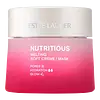What's inside
What's inside
 Key Ingredients
Key Ingredients

 Benefits
Benefits

 Concerns
Concerns

 Ingredients Side-by-side
Ingredients Side-by-side

Water
Skin ConditioningGluconolactone
Skin ConditioningButylene Glycol
HumectantIsocetyl Stearate
EmollientGlyceryl Stearate
EmollientPEG-100 Stearate
Isododecane
EmollientTriethanolamine
BufferingCyclopentasiloxane
EmollientPalmitic Acid
EmollientStearic Acid
CleansingMacadamia Ternifolia Seed Oil
EmollientArginine
MaskingGlycerin
HumectantC12-15 Alkyl Benzoate
AntimicrobialDimethicone
EmollientDiisostearyl Malate
EmollientCetyl Ricinoleate
EmollientCetearyl Alcohol
EmollientTocopheryl Acetate
AntioxidantOenothera Biennis Oil
EmollientCyclohexasiloxane
EmollientMyristic Acid
CleansingMagnesium Aluminum Silicate
AbsorbentSteareth-2
EmulsifyingXanthan Gum
EmulsifyingDisodium EDTA
Caprylyl Glycol
EmollientPhenoxyethanol
PreservativeChlorphenesin
AntimicrobialWater, Gluconolactone, Butylene Glycol, Isocetyl Stearate, Glyceryl Stearate, PEG-100 Stearate, Isododecane, Triethanolamine, Cyclopentasiloxane, Palmitic Acid, Stearic Acid, Macadamia Ternifolia Seed Oil, Arginine, Glycerin, C12-15 Alkyl Benzoate, Dimethicone, Diisostearyl Malate, Cetyl Ricinoleate, Cetearyl Alcohol, Tocopheryl Acetate, Oenothera Biennis Oil, Cyclohexasiloxane, Myristic Acid, Magnesium Aluminum Silicate, Steareth-2, Xanthan Gum, Disodium EDTA, Caprylyl Glycol, Phenoxyethanol, Chlorphenesin
Water
Skin ConditioningHeptyl Undecylenate
EmollientButylene Glycol
HumectantGlycerin
HumectantPolyglyceryl-6 Distearate
EmulsifyingTrimethylolpropane Tricaprylate/Tricaprate
EmollientButyrospermum Parkii Butter
Skin ConditioningCetyl Alcohol
EmollientNiacinamide
SmoothingLaminaria Saccharina Extract
Skin ProtectingPorphyridium Cruentum Extract
Skin ConditioningLactobacillus Ferment
Skin ConditioningHydrolyzed Rice Extract
Skin ConditioningPunica Granatum Extract
AstringentZinc PCA
HumectantDipotassium Glycyrrhizate
HumectantCamellia Sinensis Leaf Extract
AntimicrobialSodium Hyaluronate
HumectantCaffeine
Skin ConditioningNarcissus Tazetta Bulb Extract
AstringentCucumis Sativus Fruit Extract
EmollientJojoba Esters
EmollientHelianthus Annuus Seed Extract
Skin ConditioningHordeum Vulgare Extract
EmollientSucrose
HumectantSaccharide Isomerate
HumectantTocopheryl Acetate
AntioxidantSodium Phytate
Sodium Citrate
BufferingCitric Acid
BufferingPentylene Glycol
Skin ConditioningSodium Dehydroacetate
PreservativePropylene Glycol Dicaprate
EmollientXanthan Gum
EmulsifyingEthylhexylglycerin
Skin ConditioningTocopherol
AntioxidantPotassium Cetyl Phosphate
EmulsifyingCarbomer
Emulsion StabilisingSodium Hydroxide
BufferingAmmonium Acryloyldimethyltaurate/Vp Copolymer
Acrylates/C10-30 Alkyl Acrylate Crosspolymer
Emulsion StabilisingPhenoxyethanol
PreservativeWater, Heptyl Undecylenate, Butylene Glycol, Glycerin, Polyglyceryl-6 Distearate, Trimethylolpropane Tricaprylate/Tricaprate, Butyrospermum Parkii Butter, Cetyl Alcohol, Niacinamide, Laminaria Saccharina Extract, Porphyridium Cruentum Extract, Lactobacillus Ferment, Hydrolyzed Rice Extract, Punica Granatum Extract, Zinc PCA, Dipotassium Glycyrrhizate, Camellia Sinensis Leaf Extract, Sodium Hyaluronate, Caffeine, Narcissus Tazetta Bulb Extract, Cucumis Sativus Fruit Extract, Jojoba Esters, Helianthus Annuus Seed Extract, Hordeum Vulgare Extract, Sucrose, Saccharide Isomerate, Tocopheryl Acetate, Sodium Phytate, Sodium Citrate, Citric Acid, Pentylene Glycol, Sodium Dehydroacetate, Propylene Glycol Dicaprate, Xanthan Gum, Ethylhexylglycerin, Tocopherol, Potassium Cetyl Phosphate, Carbomer, Sodium Hydroxide, Ammonium Acryloyldimethyltaurate/Vp Copolymer, Acrylates/C10-30 Alkyl Acrylate Crosspolymer, Phenoxyethanol
 Reviews
Reviews

Ingredients Explained
These ingredients are found in both products.
Ingredients higher up in an ingredient list are typically present in a larger amount.
Butylene Glycol (or BG) is used within cosmetic products for a few different reasons:
Overall, Butylene Glycol is a safe and well-rounded ingredient that works well with other ingredients.
Though this ingredient works well with most skin types, some people with sensitive skin may experience a reaction such as allergic rashes, closed comedones, or itchiness.
Learn more about Butylene GlycolGlycerin is already naturally found in your skin. It helps moisturize and protect your skin.
A study from 2016 found glycerin to be more effective as a humectant than AHAs and hyaluronic acid.
As a humectant, it helps the skin stay hydrated by pulling moisture to your skin. The low molecular weight of glycerin allows it to pull moisture into the deeper layers of your skin.
Hydrated skin improves your skin barrier; Your skin barrier helps protect against irritants and bacteria.
Glycerin has also been found to have antimicrobial and antiviral properties. Due to these properties, glycerin is often used in wound and burn treatments.
In cosmetics, glycerin is usually derived from plants such as soybean or palm. However, it can also be sourced from animals, such as tallow or animal fat.
This ingredient is organic, colorless, odorless, and non-toxic.
Glycerin is the name for this ingredient in American English. British English uses Glycerol/Glycerine.
Learn more about GlycerinPhenoxyethanol is a preservative that has germicide, antimicrobial, and aromatic properties. Studies show that phenoxyethanol can prevent microbial growth. By itself, it has a scent that is similar to that of a rose.
It's often used in formulations along with Caprylyl Glycol to preserve the shelf life of products.
Tocopheryl Acetate is AKA Vitamin E. It is an antioxidant and protects your skin from free radicals. Free radicals damage the skin by breaking down collagen.
One study found using Tocopheryl Acetate with Vitamin C decreased the number of sunburned cells.
Tocopheryl Acetate is commonly found in both skincare and dietary supplements.
Learn more about Tocopheryl AcetateWater. It's the most common cosmetic ingredient of all. You'll usually see it at the top of ingredient lists, meaning that it makes up the largest part of the product.
So why is it so popular? Water most often acts as a solvent - this means that it helps dissolve other ingredients into the formulation.
You'll also recognize water as that liquid we all need to stay alive. If you see this, drink a glass of water. Stay hydrated!
Learn more about WaterXanthan gum is used as a stabilizer and thickener within cosmetic products. It helps give products a sticky, thick feeling - preventing them from being too runny.
On the technical side of things, xanthan gum is a polysaccharide - a combination consisting of multiple sugar molecules bonded together.
Xanthan gum is a pretty common and great ingredient. It is a natural, non-toxic, non-irritating ingredient that is also commonly used in food products.
Learn more about Xanthan Gum